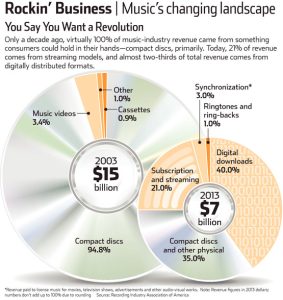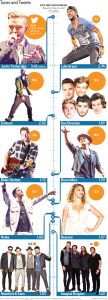Music: the Most Hotly-Debated Art Form
Have you noticed that people have stronger opinions about music than any other art form? You’ll never hear people debating the true purpose of painting or dance the way you’ll watch them hashing it out over music. Movies as take a distant second place on the heated debate spectrum. Take these questions for example:
What is the best genre of music?
Is music these days getting better or worse?
Is pop music good or garbage? What is considered “pop” anyway?
Which categories of music are good and which are garbage?
When should music be free, or should it ever be? How can performing artists ever expect to make money?

Are pop music and classical music even from the same planet? Will they ever come together, or forever remain separate entities for vastly different kinds of people?
What the Queen of Country Pop Taylor Swift Has to Say
Swift wrote an article in the Wall Street Journal about her view on recent music trends. It is pretty well-written and worth the read for anyone who takes interest in these things, as I do.
I enjoy pondering artist insights on the entertainment industry, especially from those who have achieved notable success in said industry. The assumption is that successful artists have figured out “the system” and their insights are valuable as such. However, most often these gems are buried deep within otherwise insubstantial interviews, and as such can be hard to find. It’s very rare for artists to write entire articles on industry trends, so I tip my hat to Taylor for that alone.
As with any point-of-view post, each argument Swift makes is subject to debate. I think she does well to illustrate her points with anecdotes and even some data. Yes, even some data! Swift is scoring points up the wazoo.
Responding to Taylor Swift’s Analysis
As for my response as a (much less successful) performing artist, here are arguments I agree with as well as those I dispute:
Swift’s Points I Agree with
- The music industry is not dead or even dying. It is merely going through a painful process of revolution (with no lack of proverbial bloodshed on all sides).
- In this new mobile age, selfies with celebs in the background are replacing traditional autographs.
- The number of Twitter followers celebrities have is a new metric that influences the hiring decisions of producers, directors, and other head honchos in the entertainment business.
- Social media does and will continue to play an important role in musicians’ success. This includes gaining a following before landing a record deal—in fact, using that following to actually help one get a record deal. (This is a two-edged sword. While it is now easier for independent artists to promote their music, this trend could make it much more competitive for musicians to get a prized record deal.)
- Genres, once distinct from one another, are blending into each other and blurring traditional category lines. (Except for opera. That genre is unrelentingly stubborn, I can authoritatively say as a retired opera singer. The only brave changes opera will make are visual—such as modernizing costume and set designs—not aural.)
- Music is valuable. Swift says “art is rare, and music is art.” That’s true. However, as you’ll read in the next section, I don’t think valuable things—music included—should always cost money. I think free access to art has its place in this world.
Swift’s Points I Dispute
- Swift grossly oversimplifies the reason that “just a few” albums become top-sellers these days. Her argument is that successful albums are those that hit their fans “like an arrow through the heart”, and that this fact “should challenge and motivate” recording artists to produce their best work. There are many assumptions in these statements, not the least of which is the theory that all albums purchased fall into the emotional arrow-through-the-heart category. She completely disregards the wide spectrum of motivations for purchase that include an increase in social status, gag gifts, a last-minute gift, a thoughtless gift, or the desire to have background music for parties to please the largest number of guests. Swift’s erroneous that all the top-selling albums are the most emotional ones, and that is something I think most people who know anything about music would disagree with. Sometimes an artist must choose between depth and volume. If an album is too emotional, its material may penetrate a few hearts very deeply but not inspire millions to purchase the record. By contrast, a top-selling album may be less arrow-through-the-hearty but more fun and therefore accessible to a wider audience. It’s really not a question of how emotional an album is. There are way too many other factors to consider.
- According to Swift, music should never be free. The Grateful Dead was unusual in its day because the band encouraged fans to tape record their concerts. While others called it piracy, the band called it useful promotion because their fans would then share the music with their friends. It is known that musicians make much more money from touring than they ever do from album sales. While artists like Prince are notably against people “taking advantage” of their music for free, I think every artist is entitled to making such decisions for his or her self. Amanda Palmer offers all her music for free. She makes her living by simply “asking” her fans for money as they feel moved upon to give. Many museums worldwide offer free admission to their world-class exhibits so as to make them accessible to the masses. By the same token, free music plays an important role in democratizing art. As most people and even MasterCard will agree: the most valuable things in life often have no price tag—and that can be appropriate.
Analyzing the Data
While the data in Taylor Swift’s article exited me at first, I realized that they actually were quite unrelated to her arguments. Evidently someone else shoved them into the post, feeling the need to include some kind of data in an article about music industry trends. After all, Wall Street Journal readers demand graphs and charts in their articles.

The first graph is useful, though it leads the reader to think that the music industry is, in fact, dying. The pie charts contrast record sales in 2003 to those of 2013, showing that the industry as a whole has shrunk and buying patterns have changed drastically. The caption merely explains what the data demonstrate. The article’s editor could have done better to tie it in to Taylor Swift’s narrative, explaining that in spite of apparent decline, Taylor Swift remains optimistic.
The second chart is more cluttered, confusing, and even less relevant to Swift’s remarks. The chart’s main purpose is to compare various 2013 musicians, some notably more popular than others. The chart shows the relationship between each artist’s Twitter followers and record sales. After taking the time to figure out how the chart works, which name corresponds with which picture and what all the numbers actually mean—the reader is left to conclude that there isn’t a strong or predictable correlation between one’s Twitter following and one’s album sales.
However, I decided to waste more time with this graph than the average reader, and I found there is a somewhat exponential relationship between a musician’s Twitter following and his or her album sales. Usually HIS album sales, since the chart only included one female artist among 19 male artists. Not only is this mere 5% female a skewed representation; it appears negligent that Taylor Swift is not even on the chart. So we have no way of knowing how Taylor Swift herself supports or refutes this trend. Way to go, chart maker!
Ahem, anyway . . . though not entirely reliable or predictable, there is a relationship between one’s Twitter followers and album sales. One might conclude that a large Twitter following is indicative of strong sales, though not a predictor or cause. The biggest red flag, though, is that Taylor Swift herself was not included in this selection of artists. How are we supposed to trust the numbers at all?
The person who made the chart was probably trying to make it look trendy, since you know, the music industry is so cool. However, if this person really intended for readers to visualize a relationship between “tunes and tweets, he or she should have included a bar or line graph underneath to better illustrate that. (Not to mention the title of the chart is cute but likewise confusing. The numbers don’t show how many tweets each celebrity composed nor how many individual tunes he / she sold, as the name falsely implies.)
Once again, whoever put the chart in failed to connect its message to Taylor Swift’s argument. It appears as though the attempt was to illustrate her point that one’s Twitter following is significant. However, she mentioned her “actress friend” losing a job for having a smaller Twitter fan base than the other actress who was chosen. The chart, by contrast, shows musicians other than Swift demonstrating that Twitter fans might have something to do with their album sails. Swift was talking about Hollywood hiring decisions, while the chart shows music sales. Hashtag fail.
Furthermore, the editor failed to put a caption on the chart to better connect it with Swift’s argument. Perhaps he or she consciously chose not to do so because the two really are unrelated.
Remaining Optimistic
Cynics will say it’s easy for a top-selling artist to remain optimistic about the music industry, and they have a point. I rather like Swift’s argument that the music industry is neither dead nor dying, but rather just coming alive. I do believe there is hope for the industry, especially when you consider that it remains the most hotly-debated art form by far.
And that, my friends, is one flame that social media will only continue to fan, creating more fans in the process. It is up to individual artists to find ways to navigate this rapidly-morphing sonic landscape, blazing new trails for future musicians to follow.